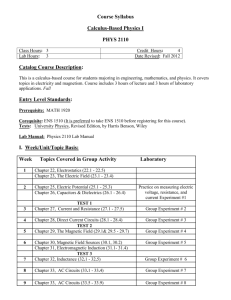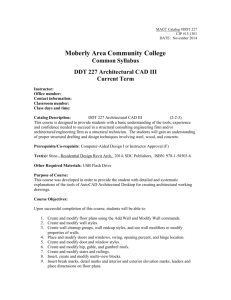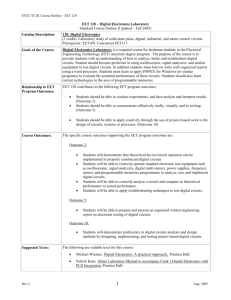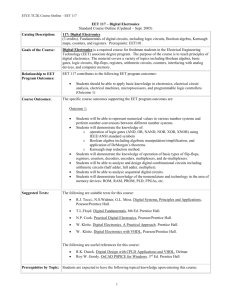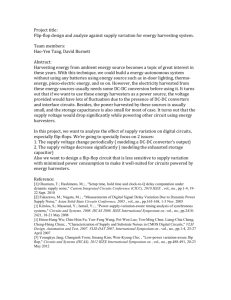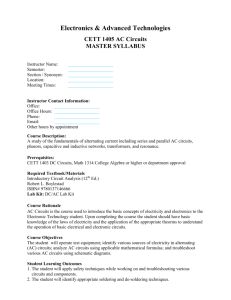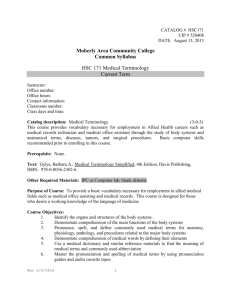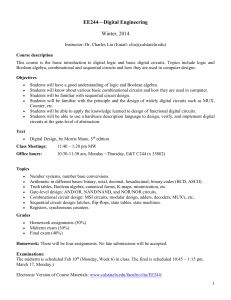EET 100 DC\AC Electrical Circuits
advertisement
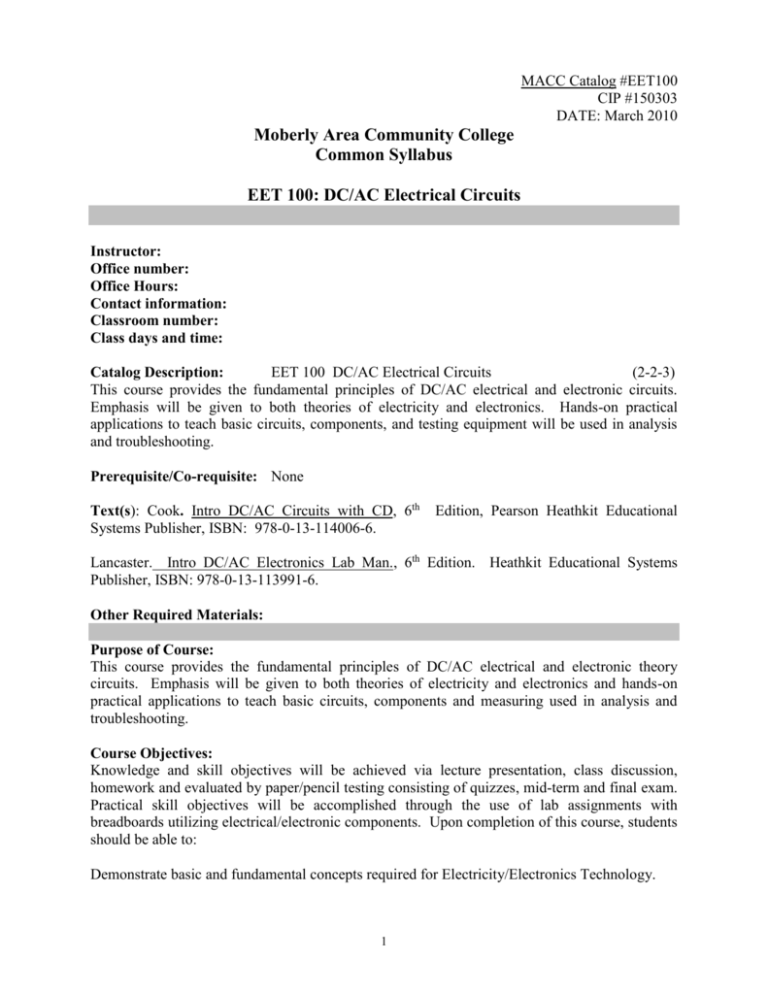
MACC Catalog #EET100 CIP #150303 DATE: March 2010 Moberly Area Community College Common Syllabus EET 100: DC/AC Electrical Circuits Instructor: Office number: Office Hours: Contact information: Classroom number: Class days and time: Catalog Description: EET 100 DC/AC Electrical Circuits (2-2-3) This course provides the fundamental principles of DC/AC electrical and electronic circuits. Emphasis will be given to both theories of electricity and electronics. Hands-on practical applications to teach basic circuits, components, and testing equipment will be used in analysis and troubleshooting. Prerequisite/Co-requisite: None Text(s): Cook. Intro DC/AC Circuits with CD, 6th Systems Publisher, ISBN: 978-0-13-114006-6. Edition, Pearson Heathkit Educational Lancaster. Intro DC/AC Electronics Lab Man., 6th Edition. Heathkit Educational Systems Publisher, ISBN: 978-0-13-113991-6. Other Required Materials: Purpose of Course: This course provides the fundamental principles of DC/AC electrical and electronic theory circuits. Emphasis will be given to both theories of electricity and electronics and hands-on practical applications to teach basic circuits, components and measuring used in analysis and troubleshooting. Course Objectives: Knowledge and skill objectives will be achieved via lecture presentation, class discussion, homework and evaluated by paper/pencil testing consisting of quizzes, mid-term and final exam. Practical skill objectives will be accomplished through the use of lab assignments with breadboards utilizing electrical/electronic components. Upon completion of this course, students should be able to: Demonstrate basic and fundamental concepts required for Electricity/Electronics Technology. 1 Course Content Direct Current: The Physics Of Electronics Composition of Matter Electrostatics Current And Voltage Current Flow Electrical Force Producing EMF Properties Of Electrical Circuits Electrical Circuit Batteries Voltage Rises/Drops Concept of Ground Resistance Electron Opposition Resistors Connecting Resistors Electrical Measurements Measuring Current Measuring Voltage Measuring Resistance OHM’S Law Determining Current Finding Voltage Finding Resistance Using OHM’s Law Power Work and Power Power, Current and Voltage Power Dissipation DC Circuits Simple DC Circuits Magnetism The Magnetic Field Electricity and Magnetism Induction 2 Course Content Alternating Current: Introduction To AC Importance Generating Sinusoidal Waveform AC Values Nonsinusoidal Waveforms Measuring AC Using Meters To Measure AC The Oscilloscope AC Resistance Basic Calculations Circuit Calculations Power In AC Circuits AC Capacitance Capacitors In AC Circuits RC Circuits RC Circuit Applications AC Inductance Inductors In AC Circuits RL Circuits RL Circuit Application Transformers Action Theory Ratios Losses Applications Statement to Connect Course with Technical Program Outcome Statement: In compliance with MACC’s General Education outcomes, the student who successfully completes this course will be able to: I. Demonstrate effective written and oral communication; Assessment of Student Learning: The EET faculty continually strives to meet the needs of their students through program improvements. These improvements are a result of program assessments and the consultation and advisement of the EET Advisory Committee. In addition to the course assessments outlined in this syllabus, the objectives achieved in this course will also be an integral part of the EET program assessment. Students will be assessed on the mastery of course concepts and essential skills attained in this course. 3 10% = Class Participation 20% = Homework/Quizzes 20% = Lab Assignments 25% = Mid-Term Exam 25% = Final Exam A = 90.0 - 100.0% B = 80.0 - 89.9% C = 70.0 - 79.9% D = 60.0 - 69.9% F = 59.9% and below The instructor may or may not use the curve grading system. Instructor Policies: Academic Dishonesty: MACC board policy is as follows: “Academic dishonesty by students damages institutional credibility and unfairly jeopardizes honest students; therefore, it will not be tolerated in any form.” Forms of academic dishonesty include but are not limited to the following: violations of copyright law, plagiarism, fabrication, cheating, collusion, and other academic misconduct. Incidents of dishonesty regarding assignments, examinations, classroom/laboratory activities, and/or the submission of misleading or false information to the College will be treated seriously. The procedure for handling academic dishonesty is outlined in the Student Handbook (Policy Handbook M.010). In cases of alleged academic dishonesty, the burden of proof is on the student, not on the instructor. Attendance: Any student who misses two consecutive weeks of class during a regular sixteen-week semester or the equivalent proportion of class time during a shorter session will be dropped from the class by the instructor unless acceptable justification is supplied. Additionally, any student who misses more than one-fourth of the entire number of in-seat class meetings in a regular 16-week semester or the equivalent proportion of class time during a shorter session, may be dropped from that class by the instructor if, in the opinion of the instructor, the student does not have reasonable opportunity to succeed in the class. A student’s attendance rate will be calculated based upon the first day of the semester (not the student’s date of enrollment in the course). Student attendance must be defined in a different manner for online, hybrid, and virtual courses. Student attendance in these courses is defined as active participation in the course. Online, hybrid, and virtual courses will, at a minimum, have weekly mechanisms for student participation, such as any or all of the following methods: a. Completion of quizzes or exams b. Submission of assignments c. Participation in threaded discussions d. Communication with the instructor A student who does not participate in an online, hybrid, or virtual course for two consecutive weeks will be dropped by the instructor unless acceptable justification is supplied. As with ground courses, a student’s attendance rate in online courses will also be calculated based upon the first day of the semester. If a student does not demonstrate active participation in the online course within 4 the first two weeks (or the equivalent proportion of class time during a short session), the student will be dropped as “never attended.” Simply logging into an online class does not constitute active participation. Students should be aware that their dropping a course and their last date of attendance in the course may impact their financial aid. Tardiness All students are expected to be on time for class. Excessive tardiness will be dealt with on a one on one basis with the instructor. Make-up and late work: No makeup work or late work will be allowed except in “extreme” instances. Extra-credit work: Extra credit may or may not be awarded. All other College Policies are located in the Student Handbook. Schedule of Student Assignments/Activities: Instructors will identify a Student Assignment/Activities schedule. Instructors have the prerogative to construct the schedule by class periods, weeks, or an overview of topics to be covered. ADA Statement Students who have disabilities that qualify under the Americans with Disabilities Act may register for assistance through the Office of Access and ADA Services. Students are invited to contact the Access Office to confidentially discuss disability information, academic accommodations, appropriate documentation and procedures. For more information, please call either the Moberly office at (660) 263-4100 x 11240 or the Columbia office at (573) 234-1067 x 12120, or visit our web page at http://www.macc.edu/index.php/services/access-office. 5


